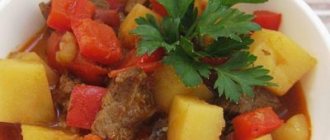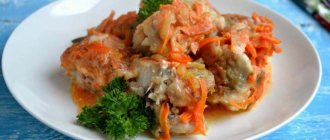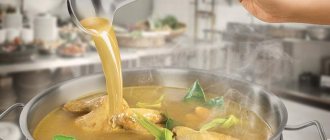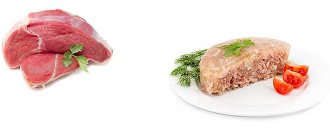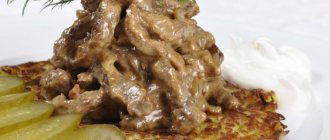Beef broth - beneficial properties and benefits of beef broth
Beef broth is a liquid broth made from the meat, bones, or byproducts of a cattle carcass. All types of beef broth contain a standard set of substances, but their quantity varies depending on what is taken as a basis: meat, bones or internal organs.
When cooked, beef meat and offal release about 2 mg of iron into the broth.
The broth contains (per 500 g):
- 237.7 mg potassium;
- 1670.6 mg sodium;
- 150.1 mg phosphorus;
- 13.2 mg selenium;
- 21.7 mg magnesium.
The uniqueness of beef broth is that, despite its low energy value, it is rich in proteins. In 100 gr. product:
- 0.61 gr. proteins;
- 0.22 gr. fat
It is inferior to chicken in terms of the amount of fat, so for those who want to lose weight, it is preferable to use beef broth. The calorie content per 100 grams of broth is 4 kcal.
How many calories are in the broth?
- 100 g of chicken broth contains 2 g of protein, 0.5 g of fat, 0.3 g of carbohydrates. The energy value of such a product is 15 kcal;
- 100 g of mushroom broth contains 0.2 g of protein, 0.02 g of fat, 0.85 g of carbohydrates. Energy value – 4.28 kcal;
- Per 100 g of vegetable broth there are 0.65 g of protein, 0.18 g of fat, 2.36 g of carbohydrates. Energy value does not exceed 12.85 kcal;
- In 100 g of fish broth from low-fat fish (for example, hake), the amount of protein is 4.49 g, fat - 0.61 g, carbohydrates - 0.71 g. Energy value - 26.15 kcal;
- Pork broth contains the most calories. 100 g of this dish contains 23.15 g of protein, 8 g of fat, and no carbohydrates. Energy value – 40 kcal;
- The calorie content of beef broth may vary. If the broth is cooked from the pulp, then per 100 g of the finished dish there will be 2.3 g of proteins, 1.1 g of fat, 2.6 g of carbohydrates. The energy value in this case will not exceed 28.8 kcal.
The calorie content of meat broth can be slightly reduced (to 28.6 kcal) if you cook it on a beef bone. In this case, 100 g of broth will contain 4 g of protein, 1.3 g of fat, 0.2 g of carbohydrates, and the energy value will be 28.6 kcal.
Based on this, we can conclude that the calorie content of meat broth (pork) will be the highest, while the calories in mushroom broth will be extremely low.
Benefits of beef broth
Having familiarized yourself with the composition of beef broth, it would be unfair to call it a useless product. The benefits of beef broth for the body are due to the elements, vitamins and compounds contained in the meat, bones and internal organs of the animal carcass.
Restores after exercise
From beef broth, the body receives iron, without which all organs and systems of the body cannot function. Iron is part of enzyme complexes called gems. Gems are components of the protein hemoglobin, which transports oxygen to all cells in the body. Iron deficiency leads to hemoglobin deficiency and this manifests itself in weakness, decreased appetite, pallor, and fatigue.
Eating beef broth will replenish iron reserves and restore strength during pregnancy, after surgery and heavy physical activity. The benefits of beef tongue broth will be greater, since the tongue contains a record amount of iron.
Accelerates weight loss
Beef broth is low in calories and at the same time satiating, so it is included in the diet of those losing weight and those watching their figure. Beef broth contains twice as much protein as fat, contains no carbohydrates, and is rich in nutrients.
Article on the topic: Characteristics of Suluguni
Helps Digestion
Macroelements, microelements, vitamins and minerals in the broth are quickly absorbed in the stomach and do not overload the digestive system. Beef-based broth is well absorbed even by a child’s body, so you can use it to prepare soups and borscht for your baby’s first feedings.
Beef bone broth has been proven to be beneficial for the digestive system. During cooking, gelatin is released from the bone tissue, which promotes the intensive release of digestive juices. Digestive juices help better assimilate the protein contained in the broth.
Copes with poisoning
A light broth made from beef or heart will be the best stomach aid for overeating and food poisoning. The amino acid methionine, which is part of the broth, will help neutralize harmful breakdown products and remove them from the body.
Allows you to digest large amounts of food
Broth will help process heavy foods in large volumes, as it stimulates the production of digestive juices, and does not require much of the body's effort to digest.
Pure beef broth is digested in 20-40 minutes. For comparison: a glass of fruit juice is digested in 30 minutes, an apple in 40 minutes.
Strengthens joints
Beef bone broth is one of the folk remedies for strengthening joint ligaments and giving elasticity.
Pay attention to the benefits of beef heart broth. The value of the heart is on the same level as beef meat, and therefore the broth is not inferior in benefits to meat-based broth. The by-product contains essential amino acids: tryptophan and methionine. Tryptophan is a source of serotonin, a hormone that is responsible for calm and clarity of mind. Methionine is the enemy of bad cholesterol, excess fat, a protector of cells from free radicals and heavy metal salts.
Calorie content of broth
When preparing broth, housewives quite often ask themselves how many calories are in the broth?
The answer to this question is not always unambiguous, since the calorie content of the broth is directly affected not only by the product from which the broth is prepared, but also by its quantity. Among all the famous first courses, broth is one of the most healthy and dietary. This is explained by the fact that, despite the calories in the broth, it has a general healing effect on the entire human body. In cooking, it is the basis for soups, sauces and many other dishes. Broth is not just a liquid. It combines many vitamins and minerals (eg magnesium, B vitamins, phosphorus, zinc). The broth can be made from a variety of products, which directly affects the calorie content of the broth. The most high-calorie ones are considered to be those prepared from fatty varieties of fish and meat. The amount of calories will be minimal in vegetable and mushroom broth. However, it should be remembered that, despite how many calories are in the broth, it still remains a very healthy and indispensable product in every person’s daily diet.
Let's take a closer look at the positive properties of broth:
- It facilitates the course of colds and viral diseases;
- Restores normal functioning of the body after the completion of a particular disease;
- Normalizes blood pressure and stomach function;
- Due to the certain calorie content of the broth, it helps improve heart function;
- Thins the blood and reduces the likelihood of blood clots.
Chicken broth is considered the healthiest of all types of broth, since this broth has a fairly low calorie content. As a result of the fact that it normalizes the functioning of the gastrointestinal tract, strengthens teeth and bones, improves memory, heals wounds, suppresses a person’s depressive state, chicken broth is prepared more often than other varieties of such dishes. In addition, people with diabetes need to consume such a dish, because chicken broth normalizes blood sugar levels.
When introducing low-calorie broths into your daily diet, you should remember that along with a large number of advantages, they also have some negative qualities. It is forbidden to use them for those people who have problems with normal metabolic processes in the body, have an ulcer or gastritis with high acidity. The reason for such prohibitions is that broth increases acidity in the stomach and also provokes a more abundant secretion of gastric juice.
Harm and contraindications of beef broth
When assessing beef broth, its benefits and harms for humans, it would be fair to talk about broth cooked with high-quality meat. An animal raised in poor environmental conditions, on synthetic feed and additives, cannot produce good meat.
High-quality meat can be spoiled in the pursuit of profit: in order to preserve the product longer, it is “saturated” with hormones, antibiotics and preservatives.
The harm of beef bone broth will appear if the cow or bull grazed on pastures near industrial plants, in places with poor ecology. Under such conditions, animal bones become saturated with salts of heavy metals that are harmful to humans.
But broth made with quality meat can be harmful to the body. Beef broth will be harmful if consumed excessively, since meat is the leader in purine content. In the human body, purines are needed for the normal functioning of the kidneys. As a result of the breakdown of purines, uric acid is formed. This is where the danger of excess substances lies. Large amounts of uric acid cause kidney problems, promote the formation of gallstones, and can cause metabolic diseases.
Article on the topic: How to cook Finnish fish soup with cream
Beef broth has contraindications:
- for gout and arthritis - due to the large amount of purines;
- children under 2 years old;
- for allergies and intolerances. This refers to beef tongue broth.
- with a weak pancreas and increased secretion of the stomach.
Calorie table
hide proteins/fats/carbohydrates | Energy value per 100 g of product
| Product | Squirrels | Fats | Carbohydrates | Kcal |
| Azu | 11.9 | 14.2 | 10.2 | 214 |
| Entrecote | 27.3 | 31.2 | 1.7 | 396 |
| Minced lamb | 17 | 23 | 282 | |
| Lamb (shoulder) | 15.6 | 25 | 284 | |
| Lamb (ham) | 18 | 18 | 232 | |
| Lamb (liver) | 18.7 | 2.9 | 101 | |
| Lamb (kidneys) | 13.6 | 2.5 | 77 | |
| Lamb (heart) | 13.5 | 2.5 | 82 | |
| Lamb (tongue) | 12.6 | 16.1 | 195 | |
| Boiled lamb | 24.6 | 21.4 | 291 | |
| Fried lamb | 20 | 24 | 320 | |
| Lamb stew | 20 | 20.9 | 268 | |
| Turkish basturma | 14.8 | 20.1 | 240 | |
| Bacon | 23 | 45 | 500 | |
| Beef Stroganoff | 21.9 | 27.4 | 5.7 | 355 |
| Steak | 27.8 | 29.6 | 1.7 | 384 |
| Boiled pork | 16.4 | 18.3 | 1 | 233 |
| Buffalo meat | 19 | 13.2 | 194 | |
| Boiled buffalo | 30 | 17.4 | 276 | |
| Fried buffalo | 33.4 | 23.2 | 342 | |
| Buffalo stew | 24.4 | 16.9 | 250 | |
| Camel meat | 18.9 | 9.4 | 160 | |
| Boiled camel meat | 29.8 | 12.4 | 230 | |
| Fried camel meat | 33.3 | 16.5 | 281 | |
| Stewed camel meat | 24.3 | 12.1 | 205 | |
| Ham | 14 | 24 | 270 | |
| Ham in shape | 22.6 | 20.9 | 278 | |
| Low fat turkey ham | 15 | 1 | 2 | 77 |
| Capercaillie | 18 | 20 | 0.5 | 254 |
| Beef | 18.9 | 12.4 | 187 | |
| Beef (udder) | 12.3 | 13.7 | 173 | |
| Beef (tenderloin) | 18.6 | 16 | 218 | |
| Beef (smoked brisket) | 7.6 | 66.8 | 632 | |
| Beef (smoked and boiled brisket) | 10 | 55 | 540 | |
| Beef (brisket) | 19.3 | 15.7 | 217 | |
| Beef (lungs) | 16.2 | 2.5 | 92 | |
| Beef (light stew) | 20.4 | 3.7 | 120 | |
| Beef (shoulder part) | 19.4 | 6.6 | 137 | |
| Beef (brains) | 11.7 | 8.6 | 124 | |
| Beef (flank) | 18.9 | 16.6 | 225 | |
| Beef (liver) | 20 | 3.1 | 4 | 125 |
| Beef (fried liver) | 22.9 | 10.2 | 3.9 | 199 |
| Beef (lean liver) | 17.4 | 3.1 | 98 | |
| Beef (trim) | 18.6 | 16 | 218 | |
| Beef (kidney) | 15.2 | 2.8 | 86 | |
| Beef (ribs) | 16.3 | 18.7 | 233 | |
| Beef (heart) | 16 | 3.5 | 96 | |
| Beef (thigh) | 20.2 | 6.4 | 138 | |
| Beef (ears) | 25.2 | 2.3 | 122 | |
| Beef (sirloin) | 20.1 | 3.5 | 113 | |
| Beef (neck) | 19.4 | 6.4 | 135 | |
| Beef (tongue) | 12.2 | 10.9 | 146 | |
| Beef (boiled tongue) | 23.9 | 15 | 231 | |
| Boiled beef | 25.8 | 16.8 | 254 | |
| Boiled lean beef | 25.7 | 8.1 | 0.2 | 175 |
| Fried beef | 32.7 | 28.1 | 384 | |
| Lean beef | 22.2 | 7.1 | 158 | |
| Roasted lean beef | 29 | 9.1 | 206 | |
| Medium fat beef | 25 | 20 | 275 | |
| Beef stew | 16.8 | 18.3 | 232 | |
| Beef goulash | 14 | 9.2 | 2.6 | 148 |
| Ground beef | 17.2 | 20 | 254 | |
| Ground beef fatty | 15 | 25 | 293 | |
| Lean ground beef | 18 | 15 | 215 | |
| Boiled goose | 19.3 | 41.2 | 447 | |
| Roast goose | 22.9 | 58.8 | 620 | |
| Game | 34 | 6.5 | 200 | |
| Seltz | 12.6 | 32 | 0.5 | 336 |
| Turkey (breast) | 19.2 | 0.7 | 84 | |
| Turkey (gizzards) | 20 | 7 | 143 | |
| Turkey (wings) | 16.5 | 11.4 | 168 | |
| Turkey (legs) | 15.7 | 8.9 | 142 | |
| Turkey (leg) | 18.4 | 6.4 | 131 | |
| Turkey (liver) | 19.5 | 22 | 276 | |
| Turkey (heart) | 16 | 5.1 | 0.4 | 128 |
| Turkey (boiled fillet) | 25 | 1 | 130 | |
| Boiled turkey | 25.3 | 10.4 | 195 | |
| Roasted turkey | 28 | 6 | 165 | |
| Turkey stuffing | 20 | 8 | 0.5 | 161 |
| Boiled-smoked carbonade | 16 | 8 | 135 | |
| horsemeat | 20.2 | 7 | 187 | |
| Boiled horse meat | 30.8 | 13 | 240 | |
| Fried horse meat | 34.3 | 17.4 | 293 | |
| Stewed horse meat | 25 | 12.7 | 214 | |
| Korean | 13.7 | 36.5 | 384 | |
| Smoked-baked loin | 10.2 | 48.2 | 475 | |
| Pork loin | 17 | 25 | 301 | |
| Raw smoked loin | 10.5 | 47.4 | 469 | |
| Lamb chops | 20.6 | 30.6 | 9.1 | 394 |
| Minced lamb cutlets | 13.6 | 14.8 | 12.9 | 240 |
| Beef cutlets | 18 | 20 | 260 | |
| Chopped beef cutlets | 14.2 | 11.4 | 13 | 213 |
| Turkey cutlets | 18.6 | 12.2 | 8.7 | 220 |
| Chicken cutlets | 18.2 | 10.4 | 13.8 | 222 |
| Chopped chicken cutlets | 15.2 | 13.6 | 13.5 | 238 |
| Pork chops | 17.5 | 40.3 | 8.8 | 470 |
| Minced pork cutlets | 13.6 | 45.7 | 466 | |
| Raw pork cutlets | 27.3 | 13.4 | 238 | |
| Veal cutlets | 23 | 31 | 375 | |
| Rabbit | 21 | 8 | 156 | |
| Roasted rabbit | 25 | 6 | 155 | |
| Chicken roll | 16 | 26 | 310 | |
| Chicken mince | 17.4 | 8.1 | 143 | |
| Minced chicken fatty | 21.3 | 11 | 0.1 | 185 |
| Chicken | 16 | 14 | 190 | |
| Chicken (breast) | 21.5 | 1.3 | 99 | |
| Chicken (boiled breast) | 29.8 | 1.8 | 0.5 | 137 |
| Chicken (smoked breast) | 18 | 5 | 117 | |
| Chicken (steamed breast) | 23.6 | 1.9 | 113 | |
| Chicken (stomachs) | 18.2 | 4.2 | 0.6 | 114 |
| Chicken (skin) | 18 | 15.6 | 212 | |
| Chicken (wings) | 19.2 | 12.2 | 186 | |
| Chicken (leg) | 16.8 | 10.2 | 158 | |
| Chicken (smoked legs) | 10 | 20 | 220 | |
| Chicken (liver) | 19.1 | 6.3 | 0.6 | 136 |
| Chicken (boiled liver) | 25.9 | 6.2 | 2 | 166 |
| Chicken (fried liver) | 30.8 | 8.9 | 2 | 210 |
| Chicken (heart) | 15.8 | 10.3 | 0.8 | 159 |
| Chicken (boiled heart) | 20 | 10.9 | 1.1 | 182 |
| Chicken (fillet) | 23.1 | 1.2 | 110 | |
| Chicken (boiled fillet) | 30.4 | 3.5 | 153 | |
| Boiled chicken | 25.2 | 7.4 | 170 | |
| Fried chicken | 26 | 12 | 210 | |
| Fried partridge | 29 | 8 | 250 | |
| Elk meat | 21.4 | 1.7 | 101 | |
| Soy meat | 52 | 1 | 17.6 | 296 |
| Venison | 19.5 | 8.5 | 154 | |
| Boiled venison | 30.8 | 11.2 | 223 | |
| Boiled and pressed venison | 27 | 2.2 | 148 | |
| Fried venison | 34.3 | 15 | 271 | |
| Venison stew | 25 | 10.9 | 198 | |
| Beef liver pate | 18.1 | 11.1 | 7 | 177 |
| Meat pate | 15 | 11 | 170 | |
| Classic beef liver pate | 9.4 | 18.7 | 2.5 | 217 |
| Quail | 18 | 18.6 | 239 | |
| Grouse | 18 | 20 | 0.5 | 254 |
| Salo | 2.4 | 89 | 797 | |
| Pork knuckle with skin | 18.6 | 24.7 | 294 | |
| Pork (boneless brisket) | 10.1 | 53 | 510 | |
| Pork (brisket with bone) | 21 | 10 | 174 | |
| Pork (grilled edge) | 21 | 35 | 400 | |
| Pork (lungs) | 14.1 | 2.7 | 85 | |
| Pork (light braised) | 16.6 | 3.1 | 99 | |
| Pork (shoulder) | 16 | 21.7 | 257 | |
| Pork (roast leg) | 27 | 20 | 290 | |
| Pork (ham) | 18 | 21.3 | 261 | |
| Pork (grilled chops) | 28 | 24 | 340 | |
| Pork (neck) | 16.1 | 22.8 | 267 | |
| Pork (liver) | 22 | 3.4 | 2.6 | 130 |
| Pork (dewlap) | 7.4 | 67.8 | 630 | |
| Pork (kidneys) | 16.8 | 3.8 | 102 | |
| Pork (ribs) | 15.2 | 29.3 | 321 | |
| Pork (heart) | 16.9 | 4.8 | 165 | |
| Pork (ears) | 21 | 14.1 | 211 | |
| Pork (neck) | 13.6 | 31.9 | 343 | |
| Pork (tongue) | 16.5 | 11.1 | 165 | |
| Boiled pork | 22.6 | 31.6 | 375 | |
| Fried pork | 11.4 | 49.3 | 489 | |
| Lean pork | 19.4 | 7.1 | 160 | |
| Pork stew | 9.8 | 20.3 | 3.2 | 235 |
| Minced pork | 17 | 21 | 263 | |
| Stewed offal | 24 | 8 | 185 | |
| Veal (lungs) | 16.3 | 2.3 | 90 | |
| Veal (light stew) | 18.7 | 2.6 | 104 | |
| Veal (shoulder) | 19.9 | 2.8 | 106 | |
| Veal (flesh) | 20.5 | 2.4 | 105 | |
| Veal (ham) | 19.9 | 3.1 | 108 | |
| Veal (liver) | 19.2 | 3.3 | 4.1 | 124 |
| Boiled veal | 30.7 | 0.9 | 131 | |
| Grouse | 18 | 20 | 0.5 | 254 |
| Pork meatballs | 7 | 10 | 12 | 172 |
| Duck | 13.5 | 28.6 | 308 | |
| Boiled duck | 19.7 | 18.8 | 248 | |
| Roast duck | 22.6 | 19.5 | 266 | |
| Pheasant | 18 | 20 | 0.5 | 254 |
| Jamon | 34.8 | 16.1 | 1.3 | 241 |
| Escalope | 19 | 42.8 | 6.8 | 487 |
Did you like the dish, but only one ingredient is missing? Be sure to pay attention to the “Replaceable Ingredients”, which contains a list of possible changes made to the recipe.
Cooking secrets
There is an opinion that there is nothing simpler than preparing broth: you need to cook a piece of meat and that’s it. This is a misconception: beef broth will turn out delicious if you know a few secrets. Since it’s not easy to find quality meat, you have to be content with what you have and know how to prepare broth from store-bought ingredients. To get the “correct” beef broth from store-bought meat, you need to cook it “in two waters”:
- Clean fresh meat from chaff and fat, rinse, cover with cold water and put on fire. If bones are used as a basis, then they should be hollow inside or “sugar”. Cut the bones into pieces, as the internal contents saturate the broth with collagen.
- Bring to a boil and cook for 5 minutes, skimming off any foam that rises to the surface.
- Remove the pan with meat from the stove and drain the water. Rinse the meat again, fill it with clean water and put it on the fire. The first water will contain harmful substances and dirt. But at the same time, in the first 20 minutes, the meat releases useful micro- and macroelements, vitamins and amino acids into the water, so for the first time do not cook the meat for more than 5 minutes.
- Bring water to a boil, skim off any newly formed foam. Reduce heat to low. The most delicious broth is obtained during long cooking over low heat.
- Cook until the meat is tender. On average, the procedure will take 1-1.5 hours.
- You need to salt the broth 10 minutes before the end of cooking.
If you need to lighten the beef broth, add egg white during cooking, and then strain the broth through cheesecloth. The proteins will absorb dirt, suspended matter and the broth will become clear. Beef broth can be used as a base for soups, borscht, cabbage soup, sauces and gravy. Dishes based on it will be nutritious, aromatic and satisfying.
Beef broth on the bone is useful for dislocations, sprains and joint instability. Beef and water are taken in a ratio of 1:3 and simmered over low heat for 12 hours. During cooking, add water to the original level.
For medicinal purposes, the resulting broth should be drunk for a week, 200 ml. in a day. Low-fat beef broth is useful in the postoperative period, for losing weight and for poisoning.
How many calories are in beef and chicken broth?
In addition to its general strengthening effect on the human body, broth is also an excellent dietary dish for those who want to lose weight. It tastes great, is nutritious, and is easy to prepare.
The calorie content of the broth depends on the type of meat product and its fat content - pork, chicken, beef, veal. This indicator is also affected by the amount of water used to cook the broth. For example, if you take 1 liter of water and 300 grams of not too fatty beef, you will get a fattier broth, the calorie content of which will be approximately 60 kcal per 100 grams of product. For those who want to lose weight, chicken broth is best; its calorie content is approximately 20 kcal per 100 grams.
Nutritionists have come to the conclusion that chicken broth is the best choice for weight loss. Primarily because the calorie content of chicken broth is significantly lower than when using other types of meat. But it’s worth considering that this indicator will depend on the chicken itself and the presence of spices in the dish. The calorie content of salted broth is slightly higher than that of fresh broth, prepared with almost no added salt, but its taste is also significantly different for the better. Therefore, it is difficult to definitively answer how many calories are in the broth. You can calculate their quantity only approximately or use the summarized table of calorie content of foods.
To make the dish healthy, you need to use only lean meat, or trim excess fat from it first. The chicken carcass must be divided into parts, placed in water and brought to a boil. After this, it is better to drain the first broth and fill the meat with clean water. Before doing this, rinse the meat well with water, add onions and herbs. This will reduce the calorie content of the broth. Also, a dish prepared in this way can be given to small children, since its high percentage of fat content will be significantly reduced with this cooking method.

